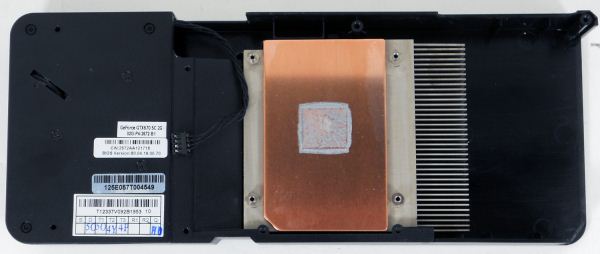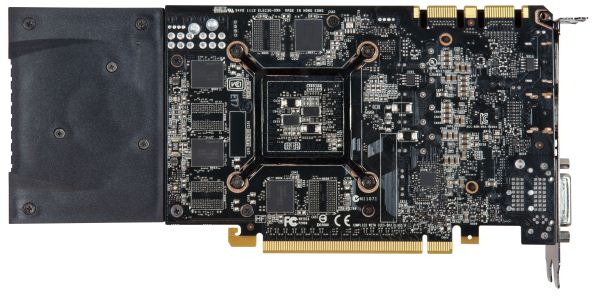NVIDIA GeForce GTX 670 Review Feat. EVGA: Bringing GK104 Down To $400
by Ryan Smith on May 10, 2012 9:00 AM ESTMeet The GeForce GTX 670
Because of the relatively low power consumption of GK104 relative to past high-end NVIDIA GPUs, NVIDIA has developed a penchant for small cards. While the GTX 680 was a rather standard 10” long, NVIDIA also managed to cram the GTX 690 into the same amount of space. Meanwhile the GTX 670 takes this to a whole new level.
We’ll start at the back as this is really where NVIDIA’s fascination with small size makes itself apparent. The complete card is 9.5” long, however the actual PCB is far shorter at only 6.75” long, 3.25” shorter than the GTX 680’s PCB. In fact it would be fair to say that rather than strapping a cooler onto a card, NVIDIA strapped a card onto a cooler. NVIDIA has certainly done short PCBs before – such as with one of the latest GTX 560 Ti designs – but never on a GTX x70 part before. But given the similarities between GK104 and GF114, this isn’t wholly surprising, if not to be expected.
In any case this odd pairing of a small PCB with a large cooler is no accident. With a TDP of only 170W NVIDIA doesn’t necessarily need a huge PCB, but because they wanted a blower for a cooler they needed a large cooler. The positioning of the GPU and various electronic components meant that the only place to put a blower fan was off of the PCB entirely, as the GK104 GPU is already fairly close to the rear of the card. Meanwhile the choice of a blower seems largely driven by the fact that this is an x70 card – NVIDIA did an excellent job with the GTX 560 Ti’s open air cooler, which was designed for the same 170W TDP, so the choice is effectively arbitrary from a technical standpoint (there’s no reason to believe $400 customers are any less likely to have a well-ventilated case than $250 buyers). Accordingly, it will be NVIDIA’s partners that will be stepping in with open air coolers of their own designs.
Starting as always at the top, as we previously mentioned the reference GTX 670 is outfitted with a 9.5” long fully shrouded blower. NVIDIA tells us that the GTX 670 uses the same fan as the GTX 680, and while they’re nearly identical in design, based on our noise tests they’re likely not identical. On that note unlike the GTX 680 the fan is no longer placed high to line up with the exhaust vent, so the GTX 670 is a bit more symmetrical in design than the GTX 680 was.

Note: We dissaembled the virtually identical EVGA card here instead
Lifting the cooler we can see that NVIDIA has gone with a fairly simple design here. The fan vents into a block-style aluminum heatsink with a copper baseplate, providing cooling for the GPU. Elsewhere we’ll see a moderately sized aluminum heatsink clamped down on top of the VRMs towards the front of the card. There is no cooling provided for the GDDR5 RAM.

Note: We dissaembled the virtually identical EVGA card here instead
As for the PCB, as we mentioned previously due to the lower TDP of the GTX 670 NVIDIA has been able to save some space. The VRM circuitry has been moved to the front of the card, leaving the GPU and the RAM towards the rear and allowing NVIDIA to simply omit a fair bit of PCB space. Of course with such small VRM circuitry the reference GTX 670 isn’t built for heavy overclocking – like the other GTX 600 cards NVIDIA isn’t even allowing overvolting on reference GTX 670 PCBs – so it will be up to partners with custom PCBs to enable that kind of functionality. Curiously only 4 of the 8 Hynix R0C GDDR5 RAM chips are on the front side of the PCB; the other 4 are on the rear. We typically only see rear-mounted RAM in cards with 16/24 chips, as 8/12 will easily fit on the same side.
Elsewhere at the top of the card we’ll find the PCIe power sockets and SLI connectors. Since NVIDIA isn’t scrambling to save space like they were with the GTX 680, the GTX 670’s PCIe power sockets are laid out in a traditional side-by-side manner. As for the SLI connectors, since this is a high-end GeForce card NVIDIA provides 2 connectors, allowing for the card to be used in 3-way SLI.
Finally at the front of the card NVIDIA is using the same I/O port configuration and bracket that we first saw with the GTX 680. This means 1 DL-DVI-D port, 1 DL-DVI-I port, 1 full size HDMI 1.4 port, and 1 full size DisplayPort 1.2. This also means the GTX 670 follows the same rules as the GTX 680 when it comes to being able to idle with multiple monitors.
















414 Comments
View All Comments
CeriseCogburn - Friday, May 11, 2012 - link
Now all you need is software - and an arm cellphone ? Or maybe a tablet with Tahiti in it ? ROFLHave fun, enjoy your winzip !
By the way nice total 180 reverse turnaround since the just prior three in a row utter compute fail amd generations.
Better get coding !
just4U - Thursday, May 10, 2012 - link
Nvidia has some nice cards out in the 670/680 now but damn.. these paper launches are fairly frustrating. It's not so much the fact that their flying off the shelves but rather they haven't made it there yet.just4U - Thursday, May 10, 2012 - link
mmm forgot to add.. atleast there appears to be more of the 670s at launch. Here in Calgary we have around 40 or so.CeriseCogburn - Thursday, May 10, 2012 - link
He doesn't know, he didn't check, he just opened the piehole and let the **** in him achieve full on rag syndrome. Give him a week. :)poohbear - Thursday, May 10, 2012 - link
erm, so what's the point of buying a 680 with this card out then? It makes the 680 a rip off, but hey all the power to the consumer!CeriseCogburn - Sunday, May 13, 2012 - link
So by extension that means the 7970 is worthless, and the 7950.Thanks for that vote.
UltraWide - Thursday, May 10, 2012 - link
Thank you for devoting time to explain the noise characteristics of the fan. It definitely makes a difference for those that don't want to add extra noise to our quiet systems.Pastuch - Thursday, May 10, 2012 - link
So there hasn't been any GTX 680s in the market for a month, 24/7 sold out. Now they release the GTX 670 , will supply continue to be constrained?Morg. - Thursday, May 10, 2012 - link
much less, since those are all failed 680's -the full gk104 at the specs nvidia picked for 680 (1.1 Ghz turbo, 200 watts) aren't going to reach mass volumes before a few months, and before then nVidia will have much more expensive silicon they wanna sell, namely 110 tesla pro stuff - which does require much better yields though since it's a huge die with important TDP limitations.
CeriseCogburn - Thursday, May 10, 2012 - link
Your idea, and frankly every other morons out there for the last number of years that the exact single unit needing to be disabled in a lesser release is the part of the gpu die that magically fails in production and allows it to be released at a lower tier is the most enormous brainfart one can ever hope for, with full head explosion from the immense pressure before the fact.I simply do not understand why people are so stupid, and so willing to show everyone else that they in fact, are.
Don't repeat the talking points man. They are not true.